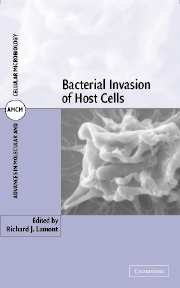Book contents
- Frontmatter
- Contents
- Contributors
- Preface
- Bacterial Invasion of Host Cells
- 1 Invasion mechanisms of Salmonella
- 2 Shigella invasion
- 3 How Yersinia escapes the host: To Yop or not to Yop
- 4 Stealth warfare: The interactions of EPEC and EHEC with host cells
- 5 Molecular ecology and cell biology of Legionella pneumophila
- 6 Listeria monocytogenes invasion and intracellular growth
- 7 N. gonorrhoeae: The varying mechanism of pathogenesis in males and females
- 8 Group A streptococcal invasion of host cells
- 9 Invasion of oral epithelial cells by Actinobacillus actinomycetemcomitans
- 10 Invasion by Porphyromonas gingivalis
- Index
- Plate section
- References
1 - Invasion mechanisms of Salmonella
Published online by Cambridge University Press: 21 August 2009
- Frontmatter
- Contents
- Contributors
- Preface
- Bacterial Invasion of Host Cells
- 1 Invasion mechanisms of Salmonella
- 2 Shigella invasion
- 3 How Yersinia escapes the host: To Yop or not to Yop
- 4 Stealth warfare: The interactions of EPEC and EHEC with host cells
- 5 Molecular ecology and cell biology of Legionella pneumophila
- 6 Listeria monocytogenes invasion and intracellular growth
- 7 N. gonorrhoeae: The varying mechanism of pathogenesis in males and females
- 8 Group A streptococcal invasion of host cells
- 9 Invasion of oral epithelial cells by Actinobacillus actinomycetemcomitans
- 10 Invasion by Porphyromonas gingivalis
- Index
- Plate section
- References
Summary
Salmonella enterica serovar Typhimurium is a facultative intracellular pathogen that causes gastroenteritis in humans and a systemic disease similar to typhoid fever in mice. Following oral ingestion, bacteria colonize the intestinal tract and then penetrate the lymphatic and blood circulation systems. Passage of eukaryotic organisms through the intestinal epithelium is thought to be initiated by bacterial invasion into M cells and enterocytes. The process of epithelial cell invasion can be studied experimentally because S. enterica serovar Typhimurium invades cultured epithelial cells in vitro. Many of the genes required for epithelial invasion have been found within eukaryotic pathogenicity island 1 (SPI-1), which is a contiguous 40-kb region at centrosome 63 of the chromosome. SPI-1 genes encode a bacterial type III secretion apparatus and several effectors, which contribute to pathogenesis through an interaction with eukaryotic proteins. The type III secretion apparatus is a multiprotein complex that is thought to build a contiguous channel across both the bacterial and epithelial cell membranes, resulting in efficient translocation of bacterial effectors directly into the cytosol of epithelial cells. The secreted effectors are thought to interact with eukaryotic proteins to activate signal transduction pathways and rearrange the actin cytoskeleton, leading to membrane ruffling and engulfment of the bacterium. This chapter discusses the mechanism by which S. typhimurium enter into host cells.
CLINICAL DESCRIPTION
S. enterica, gram-negative bacteria of the family Enterobacteriaceae, cause a variety of diseases in humans and other animal hosts.
- Type
- Chapter
- Information
- Bacterial Invasion of Host Cells , pp. 1 - 24Publisher: Cambridge University PressPrint publication year: 2004
References
- 1
- Cited by

